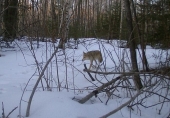In 2023 I directly sowed apple seeds into cages and still have 2 nice trees. I don't do much weeding, so I decided the trees should be at least 6" before they are placed in cages and left on their own.
I make the cages out of 1/4" hardware cloth and use them for any perennials that voles and woodchucks like to kill.
In the beginning of 2024 I made a hot house for safe seed starting and season extension. It is vole proof and easy to work in (the roof is hinged on both sides). I grew mostly apples from seed in the hot house and transplanted into pots at about 3-6". The apples stayed in pots until late summer/ fall, then some were planted in cages, given to friends, or kept in pots to overwinter in the hot house.
As of right now, I have planted 17 apples in my small yard (out of 50+ trees and over 70+ edible annual/perennial varieties). I plant everything extremely close and maintain year round living mulch by cover cropping. Most of what I grow is chop and drop soil building with plenty to bring meals into the kitchen.
I've acquired 2 acres that extends from my back yard and have already started clearing space for more planting. I've built and buried about 50 more cages and have them spaced about 3-4' apart. I will alternate planting with seedlings, cuttings, mature trees and bushes, and cover crop/ annual crop in between these rows.
I work at a restaurant and have been added hundreds of apples seeds to my hot house this winter and expect to have another 100+ seedlings to plant this coming summer.
I don't have any particular goals for what I'm doing, it's more of a compulsive curiosity. I don't mind pruning or even lethaly chopping any of my plants. I do what I need to to maintain paths and maximum photothinsasis. I will come back next winter to show this year's apples and report on their growth and habit.






